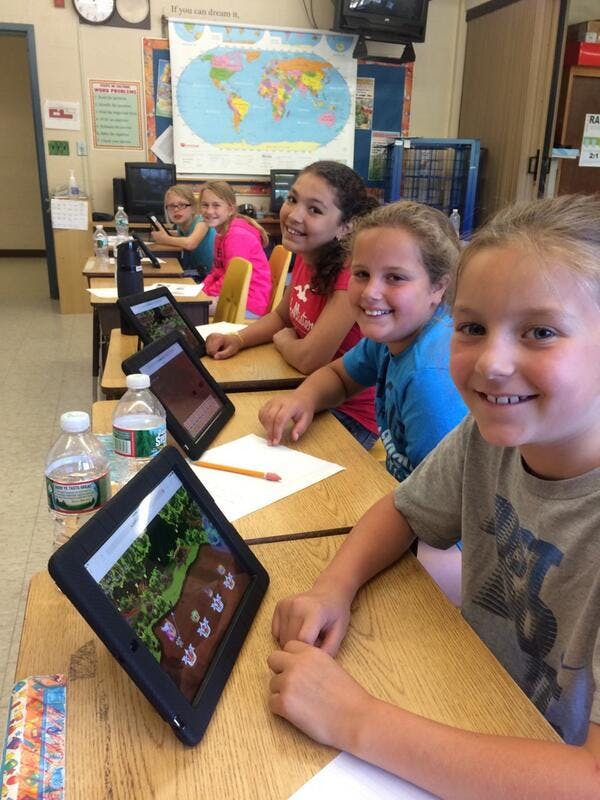20 Differentiated Instruction Strategies and Examples [+ Downloadable List]
All Posts
Written by Marcus Guido
Reviewed by Allison Sinclair, M.T.
Category
- Game-Based Learning
- Teaching Strategies
Contents
- 1. Create Learning Stations
- 2. Use Task Cards
- 3. Interview Students
- 4. Target Different Senses Within Lessons
- 5. Share Your Own Strengths and Weaknesses
- 6. Use the Think-Pair-Share Strategy
- 7. Make Time for Journaling
- 8. Implement Reflection and Goal-Setting Exercises
- 9. Run Literature Circles
- 10. Offer Different Types of Free Study Time
- 11. Group Students with Similar Learning Styles
- 12. Give Different Sets of Reading Comprehension Activities
- 13. Assign Open-Ended Projects
- 14. Encourage Students to Propose Ideas for Their Projects
- 15. Analyze Your Differentiated Instruction Strategy on a Regular Basis
- 16. “Teach Up”
- 17. Use Math EdTech that Adjusts Itself to Each Student
- 18. Relate Math to Personal Interests and Everyday Examples
- 19. Play a Math-Focused Version of Tic-Tac-Toe
- 20. Create Learning Stations, without Mandatory Rotations
As students with diverse learning styles fill the classroom, many teachers don’t always have the time, or spend additional hours to plan lessons that use differentiated instruction (DI) to suit students’ unique aptitudes.
Educator Carol Ann Tomlinson puts it beautifully in her book How to Differentiate Instruction in Academically Diverse Classrooms:
Kids of the same age aren't all alike when it comes to learning, any more than they are alike in terms of size, hobbies, personality, or likes and dislikes. Kids do have many things in common because they are human beings and because they are all children, but they also have important differences. What we share in common makes us human. How we differ makes us individuals. In a classroom with little or no differentiated instruction, only student similarities seem to take center stage. In a differentiated classroom, commonalities are acknowledged and built upon, and student differences become important elements in teaching and learning as well.
This can involve adjusting:
- Content — The media and methods teachers use to impart and instruct skills, ideas and information
- Processes — The exercises and practices students perform to better understand content
- Products — The materials, such as tests and projects, students complete to demonstrate understanding
To help create lessons that engage and resonate with a diverse classroom, below are 20 differentiated instruction strategies and examples. Available in a condensed and printable list for your desk, you can use 16 in most classes and the last four for math lessons.
Try the ones that best apply to you, depending on factors such as student age.
1. Create Learning Stations
Provide different types of content by setting up learning stations — divided sections of your classroom through which groups of students rotate. You can facilitate this with a flexible seating plan.
Each station should use a unique method of teaching a skill or concept related to your lesson.
To compliment your math lessons, for example, many teachers use Prodigy to simplify differentiation. You’ll deliver specific in-game problems to each student — or distinct student groups — in three quick steps!
Students can rotate between stations that involve:
- Watching a video
- Creating artwork
- Reading an article
- Completing puzzles
- Listening to you teach
To help students process the content after they've been through the stations, you can hold a class discussion or assign questions to answer.
2. Use Task Cards
Like learning stations, task cards allow you to give students a range of content. Answering task cards can also be a small-group activity, adding variety to classes that normally focus on solo or large-group learning.
First, make or identify tasks and questions that you’d typically find on worksheets or in textbooks.
Second, print and laminate cards that each contain a single task or question. Or, use Teachers Pay Teachers to buy pre-made cards. (Check out Prodigy Education's Teachers Pay Teachers page for free resources!)
Finally, set up stations around your classroom and pair students together to rotate through them.
You can individualize instruction by monitoring the pairs, addressing knowledge gaps when needed.
3. Interview Students
Asking questions about learning and studying styles can help you pinpoint the kinds of content that will meet your class’s needs.
While running learning stations or a large-group activity, pull each student aside for a few minutes. Ask about:
- Their favourite types of lessons
- Their favourite in-class activities
- Which projects they’re most proud of
- Which kinds of exercises help them remember key lesson points
Track your results to identify themes and students with uncommon preferences, helping you determine which methods of instruction suit their abilities.
4. Target Different Senses Within Lessons

A lesson should resonate with more students if it targets visual, tactile, auditory and kinesthetic senses, instead of only one.
When applicable, appeal to a range of learning styles by:
- Playing videos
- Using infographics
- Providing audiobooks
- Getting students to act out a scene
- Incorporating charts and illustrations within texts
- Giving both spoken and written directions to tasks
- Using relevant physical objects, such as money when teaching math skills
- Allotting time for students to create artistic reflections and interpretations of lessons
Not only will these tactics help more students grasp the core concepts of lessons, but make class more engaging.
Prodigy Math Game, for example, is an engaging way to gamify math class in a way that worksheets simply cannot. 👇
To familiarize students with the idea of differentiated learning, you may find it beneficial to explain that not everyone builds skills and processes information the same way.
Talking about your own strengths and weaknesses is one way of doing this.
Explain -- on a personal level — how you study and review lessons. Share tactics that do and don’t work for you, encouraging students to try them.
Not only should this help them understand that people naturally learn differently, but give them insight into improving how they process information.
The think-pair-share strategy exposes students to three lesson-processing experiences within one activity. It’s also easy to monitor and support students as they complete each step.
As the strategy’s name implies, start by asking students to individually think about a given topic or answer a specific question.
Next, pair students together to discuss their results and findings.
Finally, have each pair share their ideas with the rest of the class, and open the floor for further discussion.
Because the differentiated instruction strategy allows students to process your lesson content individually, in a small group and in a large group, it caters to your classroom’s range of learning and personality types.
7. Make Time for Journaling

A journal can be a tool for students to reflect on the lessons you’ve taught and activities you’ve run, helping them process new information.
When possible at the end of class, give students a chance to make a journal entry by:
- Summarizing key points they’ve learned
- Attempting to answer or make sense of lingering questions
- Explaining how they can use the lessons in real-life scenarios
- Illustrating new concepts, which can be especially helpful for data-focused math lessons
As they continue to make entries, they should figure out which ones effectively allow them to process fresh content.
But if you're struggling to see the value of journaling in a subject like math, for example, you can make time specifically for math journaling. While you connect journaling to your own math objectives, students can make cross-curricular connections.
If you want to learn more, check out K-5 Math Teaching Resources for a detailed overview. Angela Watson at The Cornerstone for Teachers also has great math journal resources you can use in your own class!
8. Implement Reflection and Goal-Setting Exercises
An extension of journaling, have students reflect on important lessons and set goals for further learning at pre-determined points of the year.
During these points, ask students to write about their favourite topics, as well as the most interesting concepts and information they’ve learned.
They should also identify skills to improve and topics to explore.
Based on the results, you can target lessons to help meet these goals. For example, if the bulk of students discuss a certain aspect of the science curriculum, you can design more activities around it.
9. Run Literature Circles
Organizing students into literature circles not only encourages students to shape and inform each other’s understanding of readings, but helps auditory and participatory learners retain more information.
This also gives you an opportunity to listen to each circle’s discussion, asking questions and filling in gaps in understanding.
As a bonus, some students may develop leadership skills by running the discussion.
This activity makes written content — which, at times, may only be accessible to individual learners with strong reading retention -- easier to process for more students.
10. Offer Different Types of Free Study Time

Free study time will generally benefit students who prefer to learn individually, but can be slightly altered to also help their classmates process your lessons.
This can be done by dividing your class into clearly-sectioned solo and team activities.
Consider the following free study exercises to also meet the preferences of visual, auditory and kinesthetic learners:
- Provide audiobooks, which play material relevant to your lessons
- Create a station for challenging group games that teach skills involved in the curriculum
- Maintain a designated quiet space for students to take notes and complete work
- Allow students to work in groups while taking notes and completing work, away from the quiet space
By running these sorts of activities, free study time will begin to benefit diverse learners — not just students who easily process information through quiet, individual work.
11. Group Students with Similar Learning Styles
Heterogenous grouping is a common practice, but grouping students based on similar learning style can encourage collaboration through common work and thinking practices.
This is not to be confused with grouping students based on similar level of ability or understanding.
In some cases, doing so conflicts with the “Teach Up” principle, which is discussed below.
Rather, this tactic allows like-minded students to support each other’s learning while giving you to time to spend with each group. You can then offer the optimal kind of instruction to suit each group’s common needs and preferences.
12. Give Different Sets of Reading Comprehension Activities

Instead of focusing on written products, consider evaluating reading comprehension through questions and activities that test different aptitudes.
Although written answers may still appeal to many students, others may thrive and best challenge themselves during artistic or kinesthetic tasks.
For example, allow students to choose between some of the following activities before, during and after an important reading:
- Participating in more literature circles
- Delivering a presentation
- Writing a traditional report
- Creating visual art to illustrate key events
- Creating and performing a monologue as a main character or figure
Offering structured options can help students demonstrate their understanding of content as effectively as possible, giving you more insight into their abilities.
13. Assign Open-Ended Projects
Similar to evaluating reading comprehension, give students a list of projects to find one that lets them effectively demonstrate their knowledge.
Include a clear rubric for each type of project, which clearly defines expectations. In fact, some teachers have their students co-create the rubric with them so they have autonomy in the work they'll be completing and being assessed on. Doing so will keep it challenging and help students meet specific criteria.
By both enticing and challenging students, this approach encourages them to:
- Work and learn at their own paces
- Engage actively with content they must understand
- Demonstrate their knowledge as effectively as possible
As well as benefiting students, this differentiated instruction strategy will clearly showcase distinct work and learning styles.
14. Encourage Students to Propose Ideas for Their Projects
As well as offering set options, encourage students to take their projects from concept to completion by pitching you ideas.
A student must show how the product will meet academic standards, and be open to your revisions. If the pitch doesn’t meet your standards, tell the student to refine the idea until it does. If it doesn’t by a predetermined date, assign one of your set options.
You may be pleasantly surprised by some pitches.
After all, students themselves are the focus of differentiated instruction — they likely have somewhat of a grasp on their learning styles and abilities.
15. Analyze Your Differentiated Instruction Strategy on a Regular Basis

Even if you’re confident in your overall approach, Carol Ann Tomlinson — one of the most reputable topic thought-leaders — recommends analyzing your differentiated instruction strategies:
Frequently reflect on the match between your classroom and the philosophy of teaching and learning you want to practice. Look for matches and mismatches, and use both to guide you.
Analyze your strategy by reflecting on:
- Content — Are you using diverse materials and teaching methods in class?
- Processes — Are you providing solo, small-group and large-group activities that best allow different learners to absorb your content?
- Products — Are you letting and helping students demonstrate their understanding of content in a variety of ways on tests, projects and assignments?
In doing so, you’ll refine your approach to appropriately accommodate the multiple intelligences of students. It's important to note, however, that recent studies have upended the theory of multiple intelligences. Regardless of where you stand on the multiple intelligences spectrum, the differentiated instruction strategy above remains valuable!
16. “Teach Up”
Teaching at a level that’s too easily accessible to each student can harm your differentiated instruction efforts, according to Tomlinson.
Instead, she recommends “teaching up.” This eliminates the pitfall of being stuck on low-level ideas, seldom reaching advanced concepts:
We do much better if we start with what we consider to be high-end curriculum and expectations -- and then differentiate to provide scaffolding, to lift the kids up.
The usual tendency is to start with what we perceive to be grade-level material and then dumb it down for some and raise it up for others. But we don’t usually raise it up very much from that starting point, and dumbing down just sets lower expectations for some kids.
Keeping this concept in mind should focus your differentiated teaching strategy, helping you bring each student up to “high-end curriculum and expectations.”
It has also grown particularly popular in the 2020s as educators have focused more on accelerated learning by "teaching up", as opposed to filling learning gaps.
As Elizabeth S. LeBlanc, Co-Founder of the Institute for Teaching and Learning, writes for EdSurge: "Accelerated learning approaches give a lower priority to repetition or 'skill-and-drill' uses of instructional technology. In other words, it’s not about memorizing everything you should have learned, it’s about moving you forward so you pick things up along the way."
Differentiated Math Instruction Strategies and Examples
17. Use Math EdTech that Adjusts Itself to Each Student

Some EdTech tools — such as certain educational math video games — can deliver differentiated content, while providing unique ways to process it.
For example, Prodigy adjusts questions to tackle student trouble spots and offers math problems that use words, charts and pictures, as well as numbers.
To the benefit of teachers, the game is free and curriculum-aligned for grades 1 to 8. You can adjust the focus of questions to supplement lessons and homework, running reports to examine each student’s progress.
Join over 90 million students and teachers using Prodigy's differentiating power today. 👇
18. Relate Math to Personal Interests and Everyday Examples
Clearly linking math to personal interests and real-world examples can help some learners understand key concepts.
Working with 41 grade 7 students throughout an academic year, a 2015 study published by the Canadian Center of Science and Education used contextual learning strategies to teach integers and increase test scores by more than 44%.
Striving for similar benefits may be ambitious, but you can start by surveying students. Ask about their interests and how they use math outside of school.
Using your findings, you should find that contextualization helps some students grasp new or unfamiliar math concepts.
There are many math-related games and activities to find inspiration to implement this tactic.
19. Play a Math-Focused Version of Tic-Tac-Toe

Help students practice different math skills by playing a game that’s a take on tic-tac-toe.
Prepare by dividing a sheet into squares — three vertical by three horizontal. Don’t leave them blank. Instead, fill the boxes with questions that test different abilities.
For example:
- “Complete question X in page Y of your textbook”
- “Draw a picture to show how to add fraction X and fraction Y”
- “Describe a real-life situation in which you would use cross-multiplication, providing an example and solution”
You can hand out sheets to students for solo practice, or divide them into pairs and encourage friendly competition. The first one to link three Xs or Os — by correctly completing questions — wins.
So, depending on your preferences, this game will challenge diverse learners through either individual or small-group practice.
20. Create Learning Stations, without Mandatory Rotations

Provide differentiated math learning opportunities for your students by setting up unique learning stations across your classrooms, but forgoing mandatory rotations.
The idea comes from a grade 9 teacher in Ontario, who recommends creating three stations to solve similar mathematical problems using either:
- Data — Provide spreadsheets, requiring students to manipulate data through trial and error
- People — Group students into pairs or triads to tackle a range of problems together, supporting each other’s learning
- Things — Offer a hands-on option by giving each student objects to use when solving questions
Only allow students to switch stations if they feel the need. If they do, consult them about their decision. In each case, you and the student will likely learn more about his or her learning style.
Supplemented by your circulation between stations to address gaps in prior knowledge, this activity exposes students to exercises that appeal to diverse abilities.
Downloadable List of Differentiated Instruction Strategies and Examples
Click here to download and print a simplified list of the 20 differentiated instruction strategies and examples to keep at your desk.
Differentiated Instruction Strategies Infographic

Here’s an infographic with 16 ideas from this article, provided by Educational Technology and Mobile Learning — an online resource for teaching tools and ideas.
Wrapping Up
With help from the downloadable list, use these differentiated instruction strategies and examples to suit the diverse needs and learning styles of your students.
As well as adding variety to your content, these methods will help students process your lessons and demonstrate their understanding of them.
The strategies should prove to be increasingly useful as you identify the distinct learning styles in — and learn to manage — your classroom.
Interested in other teaching strategies to deploy in your classroom?
Differentiated instruction strategies overlap in important ways with a number of other pedagogical approaches. Consider reviewing these supplementary strategies to find more ideas, combine different elements of each strategy, and enrich your pedagogical toolkit!
- Active learning strategies put your students at the center of the learning process, enriching the classroom experience and boosting engagement.
- As opposed to traditional learning activities, experiential learning activities build knowledge and skills through direct experience.
- Project-based learning uses an open-ended approach in which students work alone or collectively to produce an engaging, intricate curriculum-related questions or challenges.
- Inquiry-based learning is subdivided into four categories, all of which promote the importance of your students' development of questions, ideas and analyses.
- Adaptive learning focuses on changing — or "adapting" — learning content for students on an individual basis, particularly with the help of technology.
👉 Create or log into your teacher account on Prodigy — a game-based learning platform that delivers differentiated instruction, automatically adjusting questions to accommodate player trouble spots and learning speeds. Aligned with curricula across the English-speaking world, it’s used by more than 90 million students and teachers.



